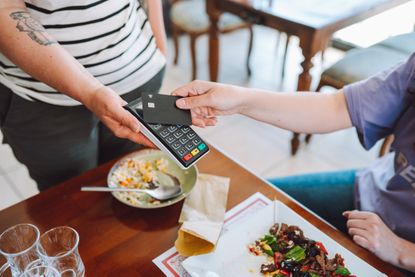A Modern Guide to When You Actually Need to Tip
Everyone from your barista to the car mechanic is asking for tips, and new technology adds to the pressure.


Tipping has long been a tricky topic, but in recent years, the practice has taken on a whole new level of complexity.
Service providers are not only increasingly soliciting tips, but they’re also spinning around touch-screen card readers with suggested percentages that can run as high as 30%. Adding to the struggle are bills with a “service charge” and a line for gratuity. And then there’s the awkwardness of making a tipping decision while standing two feet from the person who just handed you your take-out pizza.
“It’s a very complicated space,” says Lizzie Post, co-author of Emily Post’s Etiquette, The Centennial Edition, and the great-great-granddaughter of manners maven Emily Post.

Sign up for Kiplinger’s Free E-Newsletters
Profit and prosper with the best of expert advice on investing, taxes, retirement, personal finance and more - straight to your e-mail.
Profit and prosper with the best of expert advice - straight to your e-mail.
So, how did the gracious act of adding a gratuity become so confounding? The global pandemic was a major impetus, as many consumers, while holed up in their homes, wanted to support small businesses and show appreciation for service workers.
“Covid increased people’s willingness to tip even in circumstances where you weren’t used to it,” says Michael Lynn, a Cornell University professor of consumer behavior and marketing who has published more than 50 academic papers on service gratuities. “It also increased their willingness to tip larger amounts.”
In addition, credit card readers that give suggestions such as 18%, 20% and 25% are more prevalent than ever — and unlike tip jars, they can cause extra gratitude angst because you must opt out. “With a tip jar, failure to tip is passive. It’s a sin of omission,” says Lynn. “Whereas failure to tip with the digital screen is more active. You have to say, ‘No tip.’ And we generally think sins of commission are worse than sins of omission.”
Across the country, tip jars are proliferating, and digital prompts show no sign of abating. Still, you can take steps to feel good about the amount you tip — if you tip at all.
Familiarize yourself with tipping norms. Tipping is a personal choice, but getting some insight can help you make more-informed decisions. If you’re uncomfortable, you could spend money in ways that don’t align with your personal or financial values. Some general guidelines from the Emily Post Institute:
- Wait service at a sit-down establishment: 15% to 20% of the total.
- Food delivery:10% to 15% of the bill. (Take note: Food delivery fees are typically separate from gratuities.)
- Food take-out: This is discretionary, but it’s common to tip 10% or a few dollars depending on the size of the order.
- Tipping jars for baristas or other service workers: This is also discretionary. Consider tipping if your server goes above and beyond or you’re a regular customer. Depending on the amount, you can put your change in the jar or add a dollar or two on top of the total bill.
It’s fine to go above these suggested amounts, as well as tip pretax. Emily Post’s Etiquette, The Centennial Edition has a more extensive list of guidelines, including for cannabis delivery service (up to 15% of your order).
Create internal guidelines. Once you grasp the norms, think through what feels right for you. This way, you’ll be mentally prepared the next time you stare down digital gratuity suggestions or a tip jar that says, “Show us some love.”
“Everyone needs to come up with their own set of guidelines for situations around tipping, giving or donating,” says Bari Tessler, a financial therapist and author of The Art of Money. “It helps us when we’re faced with these moments.”
For instance, if you want to save money by picking up food from a restaurant instead of dining in or ordering delivery, think through what percentage, if any, fits your needs. “We’re all on our own budgets,” says Post, who is also co-president at the Emily Post Institute. “Not everybody can afford to tip 20% all the time, which is why some people go to a take-out place — that expectation isn’t there.”
As you form your internal guidelines, keep in mind that some workers — such as waiters and bartenders — often rely on tips for a large part of their income. Post says to consider tipping a restaurant worker at least 15% even if you’re displeased with the service or the meal. “Use your words, not your money, to speak for you,” she says. “Let the manager know why your experience was so unsatisfactory.”
When you apply your personal principles, be sure to give yourself some wiggle room. It’s helpful to have a baseline, but circumstances can vary. Your final decision will likely be based on the bill amount, your budget, the complexity of your request and the quality of the service. “There are a lot of things that can factor into your tip amount,” says Post. “And sometimes it’s just wonderful customer service.”
Expect the unexpected. Whether at a fast-food chain or your local dry cleaner, be prepared for tip prompts from more unexpected places. When that happens, try to pause for a moment or two instead of making a knee-jerk decision. Is spending 20% more worth it to you? And even if you overspend on a “guilt tip” because you feel flummoxed, be gentle with yourself, Tessler says. “We’re always learning from these experiences and fine-tuning as we go. The next time you’re in that situation, you can always do it differently.”
Service charges, which can appear on a bill alongside a request for a tip, are often a source of confusion. Your best bet: Ask the person serving you or the establishment’s manager to explain what the charge covers.
Permit yourself to skip the tip. Gratitude researcher Lynn says he generally tips waitstaff, bartenders, food-delivery workers and hotel housekeepers. Otherwise, “I don’t feel obligated to tip,” he says. “I’m not opposed to tipping, but I have to have a reason to tip, which means I almost never tip for counter service. When they turn those screens around, I hit the ‘no tip’ option, and I don’t feel bad about it.”
Post says that it’s fine not to tip if you don’t want to do so in certain circumstances, but she says it’s always important to show appreciation. “Say please, thank you, excuse me,” says Post, who has worked as a busser, server and cocktail waitress. “I would so much rather you treat me well than spend your time deciding between 10% and 15% on the tablet I just turned around for you.”
Note: This item first appeared in Kiplinger's Personal Finance Magazine, a monthly, trustworthy source of advice and guidance. Subscribe to help you make more money and keep more of the money you make here.
Related Content

Kiplinger contributor Laura Petrecca is a business journalist who has worked at major media organizations such as Gannett, News Corp, and Crain Communications. Prior to launching her own writing business, she held leadership roles such as USA Today’s New York City bureau chief, special projects editor, and business section editor.
In addition to Kiplinger, her writing has appeared in USA Today, Real Simple, Men’s Health, Prevention, Crain’s New York Business, Advertising Age, and AARP Bulletin. Laura also hosts livestream videos and has offered commentary on TV programs such as the Today show, Good Morning America, Inside Edition, Access Hollywood, and CNN.
She earned a master’s degree in journalism and a certificate in economics and business journalism from Columbia University and a bachelor's degree in journalism from the University of Maryland.
-
-
 Putting Catch-Up Contributions Into a Roth 401(k) Isn't a Bad Idea
Putting Catch-Up Contributions Into a Roth 401(k) Isn't a Bad IdeaRoth 401(k) High earners will be required to put their catch-up contributions in a Roth 401(k).
By Sandra Block Published
-
 Work Email Phishing Scams on the Rise: The Kiplinger Letter
Work Email Phishing Scams on the Rise: The Kiplinger LetterThe Kiplinger Letter Phishing scam emails continue to plague companies despite utilizing powerful email security tools.
By John Miley Published
-
 Tips For Open Enrollment 2023
Tips For Open Enrollment 2023Open enrollment will soon be underway, and many employers are shielding workers from hefty increases in health insurance premiums. But it pays to review your options carefully.
By Kimberly Lankford Published
-
 7 Stocks to Give Your Grandchildren
7 Stocks to Give Your GrandchildrenA pick of stocks to give your grandchildren as long-term gifts.
By Dan Burrows Published
-
 How to Make Charitable Gifts With an IRA
How to Make Charitable Gifts With an IRAIf you make charitable gifts with an IRA, you can get a tax break. Here's how to do it.
By Joy Taylor Published
-
 Credit Card Rewards Are Safe for Now
Credit Card Rewards Are Safe for NowYes, your credit card rewards are safe for now, but are you maximizing points and miles?
By Emma Patch Published
-
 How to Manage Adoption Costs
How to Manage Adoption CostsAdopting a child can be expensive, but subsidies and tax breaks are available.
By Ella Vincent Published
-
 Is It A Good Time To Cash In Your I Bonds?
Is It A Good Time To Cash In Your I Bonds?Given certain economic forces, this may be the right time to cash in your I bonds.
By Sandra Block Published
-
 Why Investors Should Be Patient With Commodities
Why Investors Should Be Patient With CommoditiesThe momentum in commodity prices has stalled this year as inflation has cooled, but some strategists are eyeing a rebound in 2024 – which could benefit this mutual fund.
By Nellie S. Huang Published
-
 How to Master Index Investing
How to Master Index InvestingIndex investing allows market participants to use baskets of stocks and bonds to build the best portfolio to meet their goals. Here's how it works.
By Nellie S. Huang Published









